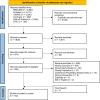Barriers and facilitators to implementation of musculoskeletal injury mitigation programmes for military service members around the world: a scoping review
- PMID: 37620010
- PMCID: PMC10715562
- DOI: 10.1136/ip-2023-044905
Barriers and facilitators to implementation of musculoskeletal injury mitigation programmes for military service members around the world: a scoping review
Abstract
Introduction: Musculoskeletal injury (MSK-I) mitigation and prevention programmes (MSK-IMPPs) have been developed and implemented across militaries worldwide. Although programme efficacy is often reported, development and implementation details are often overlooked, limiting their scalability, sustainability and effectiveness. This scoping review aimed to identify the following in military populations: (1) barriers and facilitators to implementing and scaling MSK-IMPPs; (2) gaps in MSK-IMPP research and (3) future research priorities.
Methods: A scoping review assessed literature from inception to April 2022 that included studies on MSK-IMPP implementation and/or effectiveness in military populations. Barriers and facilitators to implementing these programmes were identified.
Results: From 132 articles, most were primary research studies (90; 68.2%); the remainder were review papers (42; 31.8%). Among primary studies, 3 (3.3%) investigated only women, 62 (69%) only men and 25 (27.8%) both. Barriers included limited resources, lack of stakeholder engagement, competing military priorities and equipment-related factors. Facilitators included strong stakeholder engagement, targeted programme design, involvement/proximity of MSK-I experts, providing MSK-I mitigation education, low burden on resources and emphasising end-user acceptability. Research gaps included variability in reported MSK-I outcomes and no consensus on relevant surveillance metrics and definitions.
Conclusion: Despite a robust body of literature, there is a dearth of information about programme implementation; specifically, barriers or facilitators to success. Additionally, variability in outcomes and lack of consensus on MSK-I definitions may affect the development, implementation evaluation and comparison of MSK-IMPPs. There is a need for international consensus on definitions and optimal data reporting elements when conducting injury risk mitigation research in the military.
Keywords: community; implementation / translation; military; systematic review.
© Author(s) (or their employer(s)) 2023. Re-use permitted under CC BY-NC. No commercial re-use. See rights and permissions. Published by BMJ.
Conflict of interest statement
Competing interests: NA reports grants from Centre for Sport, Exercise & Osteoarthritis Research Versus Arthritis, outside of the submitted work. SdlM reports grants from the Congressionally Directed Medical Research Programme and the Veterans Affairs/Department of Defense Health Affairs Joint Incentive Fund, outside of the submitted work. JJF reports grants from Congressionally Directed Medical Research Programme and the Office of Naval Research, outside of the submitted work. In addition, JJF has a patent pending for an Adaptive and Variable Stiffness Ankle Brace, US Provisional Patent Application No. 63254,474. AR reports grants from the Concussion in Sport Group, Alberta Bone and Joint Strategic Clinical Network, Tonal Strength Institute, outside of the submitted work. DIR reports grants from the Congressionally Directed Medical Research Programme and the National Institutes of Health, outside of the submitted work, and grant support for the submitted work from the Uniformed Services University, Department of Physical Medicine & Rehabilitation, Musculoskeletal Injury Rehabilitation Research for Operational Readiness programme (MIRROR HU00011920011).
Figures


Similar articles
-
Perceived barriers and facilitators to implementation of injury prevention programs in the military: Feedback from inside the trenches.Injury. 2025 Feb;56(2):112029. doi: 10.1016/j.injury.2024.112029. Epub 2024 Nov 20. Injury. 2025. PMID: 39608135
-
Implementation interventions for musculoskeletal programs of care in the active military and barriers, facilitators, and outcomes of implementation: a scoping review.Implement Sci. 2019 Aug 16;14(1):82. doi: 10.1186/s13012-019-0931-1. Implement Sci. 2019. PMID: 31419992 Free PMC article.
-
Musculoskeletal Complaint Epidemiology in Australian Special Operation Forces Trainees.Mil Med. 2023 Nov 3;188(11-12):e3539-e3546. doi: 10.1093/milmed/usad215. Mil Med. 2023. PMID: 37311061 Free PMC article.
-
Strategies used for childhood chronic functional constipation: the SUCCESS evidence synthesis.Health Technol Assess. 2024 Jan;28(5):1-266. doi: 10.3310/PLTR9622. Health Technol Assess. 2024. PMID: 38343084 Free PMC article.
-
Barriers and Facilitators for Implementing Interventions for Treating Patients With Chronic Musculoskeletal Pain: A Qualitative Scoping Review Using the Theoretical Domains Framework.Musculoskeletal Care. 2025 Jun;23(2):e70108. doi: 10.1002/msc.70108. Musculoskeletal Care. 2025. PMID: 40286105 Free PMC article.
Cited by
-
Methodology used to develop the minimum common data elements for surveillance and Reporting of Musculoskeletal Injuries in the MILitary (ROMMIL) statement.F1000Res. 2025 Apr 3;13:1044. doi: 10.12688/f1000research.152514.2. eCollection 2024. F1000Res. 2025. PMID: 39649840 Free PMC article.
-
A whole system approach to promoting health and human performance in military settings as vital prerequisites for force readiness and operational capability.Front Physiol. 2025 Apr 8;16:1541256. doi: 10.3389/fphys.2025.1541256. eCollection 2025. Front Physiol. 2025. PMID: 40265154 Free PMC article. Review.
-
Minimal Data Elements for Surveillance and Reporting Of Musculoskeletal injuries in the MILitary (ROMMIL) International Consensus Statement.Med Sci Sports Exerc. 2025 Sep 1;57(9):1914-1922. doi: 10.1249/MSS.0000000000003737. Epub 2025 Apr 23. Med Sci Sports Exerc. 2025. PMID: 40263753 Free PMC article.
-
Determinants of Medical Care-Seeking Behavior for Musculoskeletal Conditions During US Marine Corps Training: A Thematic Analysis.J Athl Train. 2024 Dec 1;59(12):1203-1212. doi: 10.4085/1062-6050-0707.23. J Athl Train. 2024. PMID: 38894683
-
Pre-academy knee pain as a predictor of overuse knee injuries in first-year military cadets.BMJ Mil Health. 2025 Aug 11:military-2025-003033. doi: 10.1136/military-2025-003033. Online ahead of print. BMJ Mil Health. 2025. PMID: 40789695 Free PMC article.
References
Publication types
MeSH terms
LinkOut - more resources
Full Text Sources
Medical
Miscellaneous
